
JACK HANLEY - NEEDLES & PENS
ARTST-XCHANGE - ARTISTS' TELEVISION ACCESS
SILVERMAN GALLERY
REVIEWED BY KEVIN CLARKE
06.01.07
Jack Hanley Gallery : Colter Jacobsen - Light Falls.
Comment: I wonder how the passage of an object from discarded to 'found,' and then re-contextualized might be analogous to the transformation of an image through memory and medium? What's wonderful about Colter Jacobson's show is how he recognizes the ambiguity of authorship, the power of an image or a wrapper or a sentence, (as in the words from "bill" by Bill Berkson series) to be re-contextualized, and the idea that there is something spiritual and transcendental in the execution of memory. He is both killing the past and paying homage to it while carrying out the movement of mechanical pencil on paper to give the keystone-- the mental image-- a tangible place hovering above and between the source and the final product.
My absolute favorite part of the show is the photograph of a framed photograph of a painting with the flash reflecting off the glass, and the accompanying drawings, divined through Jacobsen's process of drawing the photo and then later, drawing the memory of the drawing of the photo. The starting point of that trek is a photo of a painting of the high seas By Donal Mosher. It's the white light in the middle that makes it magic.
There are three pictures presented in "Light Falls" without alteration. That is, three images that are the first generation article. A page torn from an old book with the printed vignette of a nineteenth century woman sitting and looking away from the lens with her hands folded in her lap. Beneath the image are the words in all capitals, THE AUTHOR. Another is a photograph of a person, I'm assuming Jacobsen, covering his face with a mask made from the torn image of a waterfall pouring into a large body of water. There are two holes for eyes to see through the mask and the waterfall is positioned so it appears to be pouring directly from the center of his forehead. The third image is a found snapshot of a child being thrown high into the air at church.
Gesamtkunstwerk is a German word that translates to 'total work of art.' This show seems like it is one installation trying to be a total work of pictures. Not because every type of image is represented, but because the meditation that creates an image, the keystone of images-- the mental image-- is the ghost in the machine uniting the parts of "Light Falls." There is a waterfall coming out of Colter Jacobsen's forehead, a quasi-spiritual meditation on the potential of recreating an image (the potential simulacrum), as it exists in the artist's mind before becoming form. This is Baudrillard's simulacrum that "is not a copy of the real, but becomes truth in its own right." Jacobsen is not simply questioning the originality of images like those of Sherrie Levine or Cindy Sherman; he is creating a shrine for the process of an image's transmutation.
The first thing we see when we walk into Jack Hanley is an assemblage cross, culled from package cardboard, cutouts of icons, arrows, logos, and ads. At its base is a pile of gold and silver plastic wrappers and other collected shiny reflective trash like a mound of treasure. To the right and left of the cross are pairs of lamps that appear to be illuminating a portal into deep space-- a black circle on the wall above each lamp with little white specks for stars. I got wonderfully lost in that space and then glanced down to see a painting of a girl being tossed into the air at church. On the opposite wall was the actual photo with lamps on either side as well. All of this seems to represent a portal of reverence for the space Jacobson goes to draw.
The other theme in "Light Falls" is dualism. The dualism can be seen in "On the Street a Dream (Missing the Mint)," "Looking for an Honest Lamp," and in all of the hand painted and drawn pairs and the thrift store paintings. In "On the Street," neatly arranged silver and gold gum wrappers surround a framed composition of two stickers, one with the black outside peel intact but nothing in its circular center, and the other a circle with no surrounding sticker. It reads as hole and whole. 'There' next to 'missing,' found with lost, or original mundane fact and reclaimed sacred identity. The dialogue discussing the middle point between two states of being throughout the show is an appreciation of the dyad. Not its two parts, but the fact that the linking of the two makes a unit.
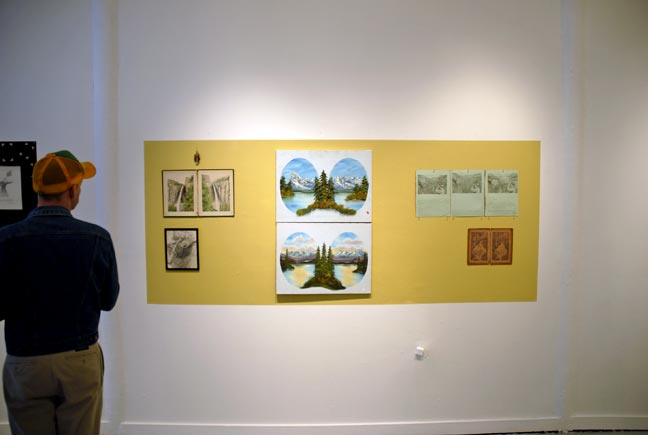
Art.
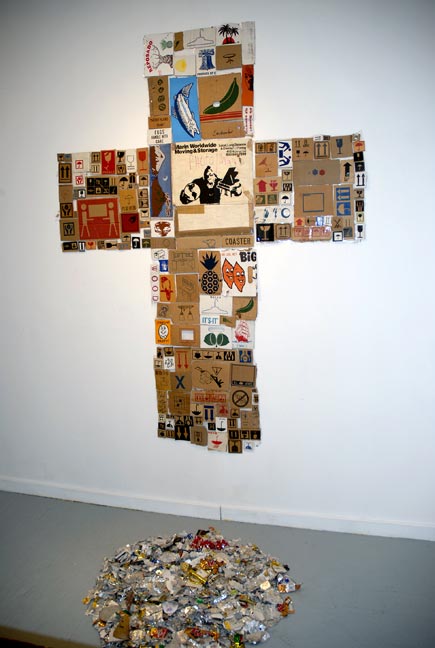
Art.
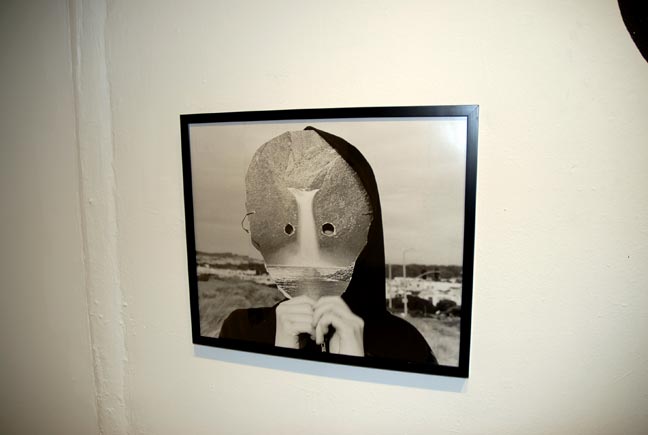
Art.
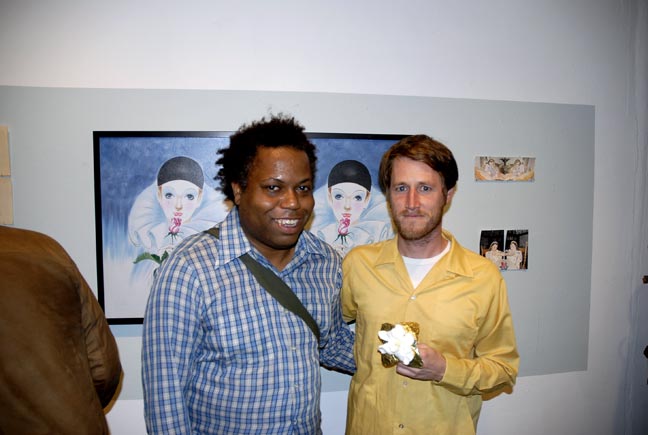
Colter Jacobsen (right) and associate.
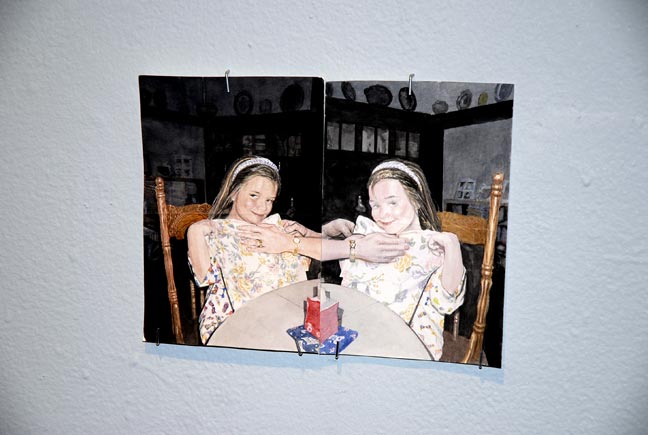
Art.
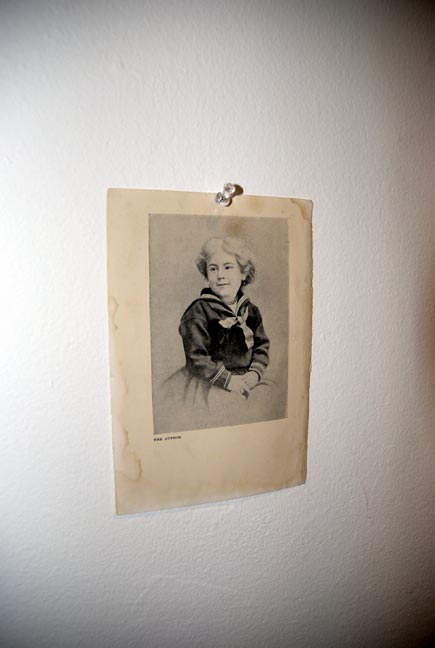
Art.
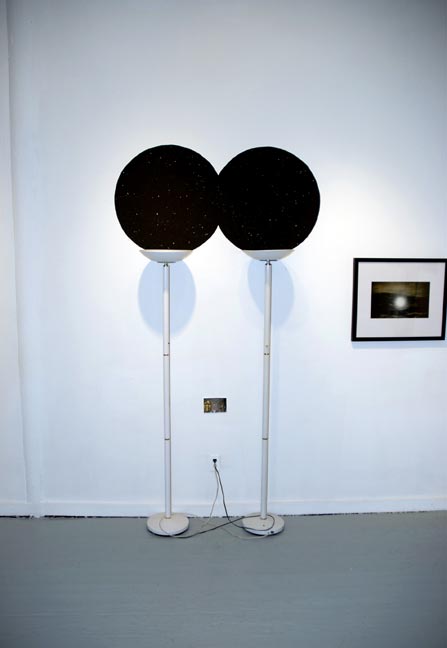
Art.
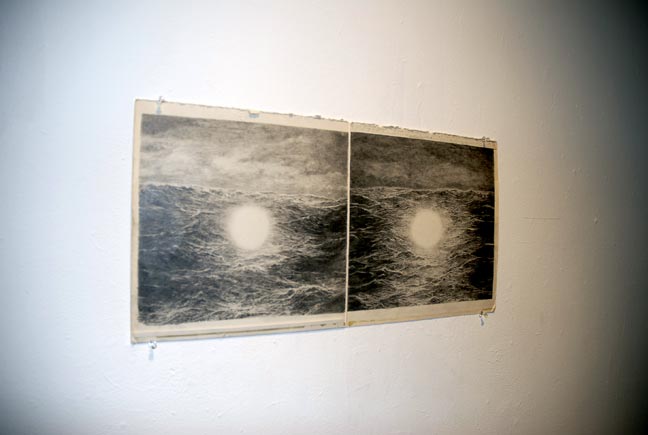
Art.
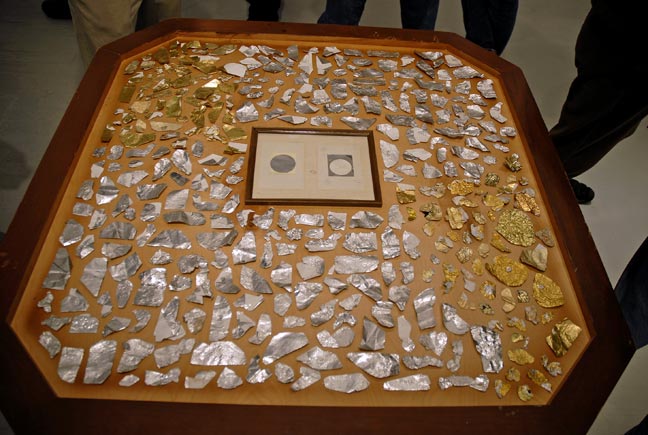
Art.

Art.
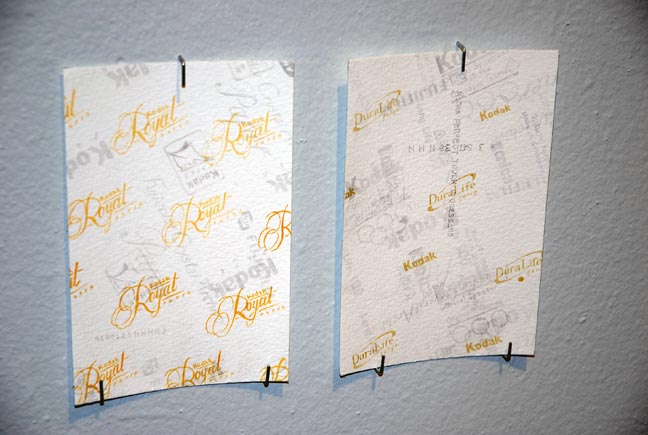
Art.

Layout.
***
Needles & Pens : David Benzler - Ill With The Thrill Of The Chase.
Comment: I like the way David Benzler uses flat graphic shapes and lines with overlapping perspectives to create masses of form color, floating in blackness above or below horizon lines.
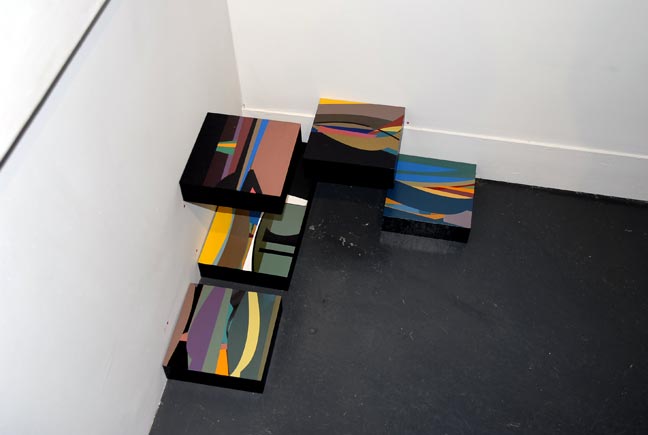
Art.

Art.

Art.

David Benzler - Andrew McKinley of Adobe Books.
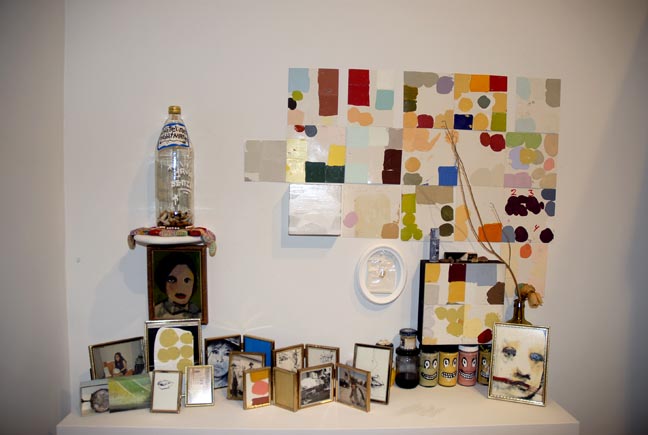
Art.
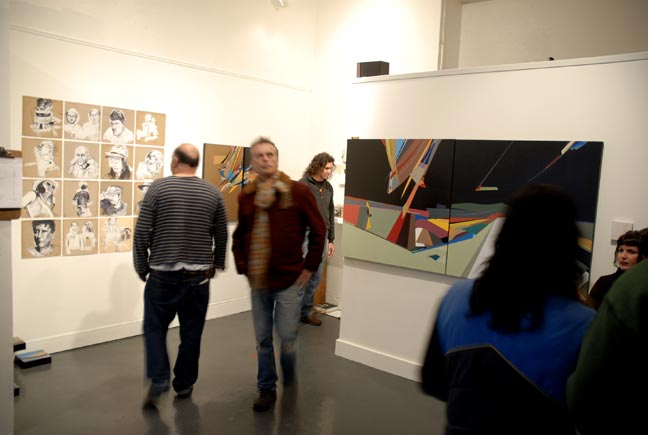
Playing field.
***
Artist-Xchange Gallery : Group Show.
Artists: Mike Lanni, Joshua Hagler, Mike Kimball, Mati Rose McDonough, Dana Robson, Eric Brooks, Mario Giordano, Luke Feldman, David Delany, Slim Arts, Ursula Xanthe Young, David Garvey, Earthyly Treasures by Amy Levine, Aiko Designs, Niana Liu, Jester Swink by A. Rae Gedlaman, Vicki Morawietz-VAM, Ayu Tomikawa, SAA Z Designs, Randy Antin, Ulterior Votive by Jackie Jay, Chris Smallwood, Sawyer Rose, Hilary Williams, Michael-Che` Swisher, Mary Tivadar, Chuck Drees, Agustin Cas, Hang Nguyen, Hiroko Sakai, Kim Weinberg, Joshua Ellingson, Cameron Forsley, Arista Andrews, Szoenyi, Allison Kreft, Fives Omnimedia, Muscovie Design, Falbs Glass, Simseema, Green Halo Designs, Elizabeth Ben Porat, Sokoala, MZZ T RZZ, Gabriel Colaluca, Steven Wilber, Alice Gibbons, Joanna Mendicino, Ruth Jacobson, Glenn Walker, Winsa Lam, Maya Delano, Lisa LaRocca, Howard Chew, Kato's Charm, JBalducci, Kmaley Design, Azukre Aho, Anja Buckle, Emine Keskin, MeeshMeesh Designs, Steven Lewis Designs, Grace Goce, Meri Page.
Comment: Monthly group show.
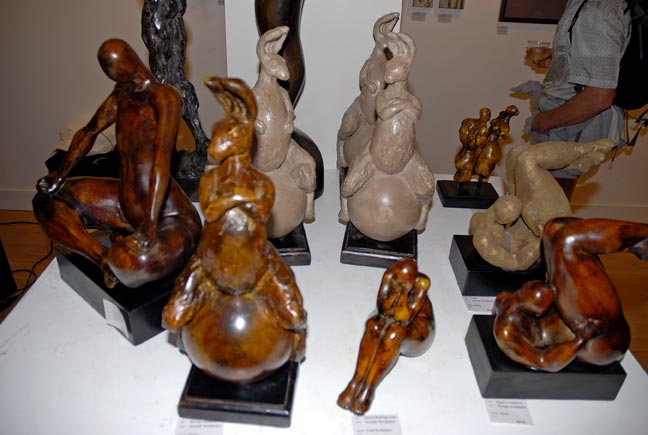
Art.
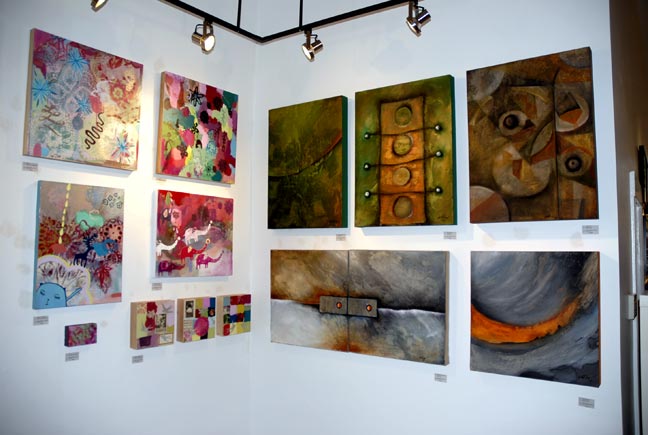
Art.

Art.

Art.
***
Artists' Television Access : Stephen Slappe - Increasing In Significance.
Comment from AB: Thank you Kevin for finally covering a show here. This institution has successfully eluded me since the inception of my compulsion.
Comment: In 'Increasing In Significance,' a four-channel video displayed in horizontal succession in the front window of ATA, Stephen Slappe presents the viewer with four locations, shot by a camera rotating at a constant rate. We see a graveyard, an intersection, an industrial open lot surrounded by freight trains and debris, and the rooftop of a warehouse, all turning from right to left. Then we see the artist enter each of these places at various distances and at different times. The further away he is, the more effort he has to exert to keep inside the turning frame. In each of the four displays the artist increases his distance from the camera until he struggles to keep up, and then fades out of the picture while the camera keeps turning.
Slappe explains on the ATA website that 'Exploiting the illusionism of relative motion, the camera captures the necessity of an individual trying to keep pace with a constantly moving environment while revealing the ultimate futility, and humor, of that effort.' He also says that two sources of inspiration were 'Johannes Kepler, the mathematician who discovered the elliptical orbits of planets, and Buster Keaton, the silent film actor and director.'
Having had a day to think about Slappe's piece and the conversation that followed, I'm left with the feeling that what I saw and felt matched his intention. The feeling is about trying to keep up with a difficult task, but as an artist specifically, staying in the viewer's eye, being relevant in the discourse, and the fact that an artist's struggle to communicate with an audience may go away while life keeps going on around him, and eventually, without him. It is the moment that the person running through the frame fades away where the dialogue of artist's message and viewer response, emboldened by the metaphor of planetary relativity, is supplanted by the gravity of a monologue emanating from the axis point of The Camera. The camera begins to stand alone as the judge and omnipotent intermediary, and could be seen as the gallery, the critic, or any institutional approval with the power to increase one's significance.

Video art in the front window.
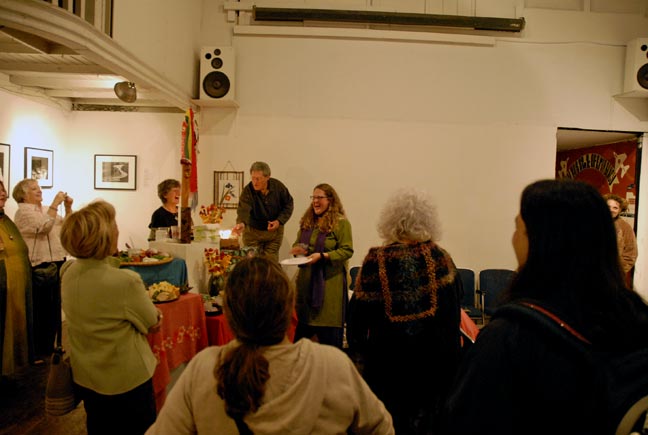
Refreshments and social activities inside.

Video art in the front window cont.
***
Silverman Gallery : Ben Shaffer - With signs following.
Comment: Ben Shaffer uses cryptic art historical references, religious superstition, and pop political currents to inform 'With signs Following.' His titles are often times humorous references to his friends, movies and songs, like the title of a song from spinal tap, 'Where The Demons Dwell,' but sometimes reference more singular concepts like 'The Beard' or 'Hair of God.' He meticulously crafts and colors his assemblages of signifiers-- but it is the signified that, if actualized in one piece by the addition of a title, obfuscates its 'sign' and compounds the confusion when considering another piece. The words that accompany these elements are best when direct and descriptive. In other words, when each unit seems a disciplined-while-dense collection and use of color, materials (like mirrors, dirt, Fimo, paint, rattlesnake,) and representations of things (like 'monkey' 'kaleidoscope' 'mini Stonehenge on a mini hill' 'dunce cap') and the addition of ideas (like 'snake charmer/religious zealot' 'Hellenistic sculpture' 'wind chime' 'terrorism'), the title should not be an inside joke that disorients things further. Each piece is an amazingly crafted unit. What I wonder is, are the signs 'following' in tow of each piece, like remnants in the wake of the final art object, or are the signs supposed to materialize in my mind after I've left the show? Like, just give it awhile, it'll come to you.
Shaffer has created a space that I relate to as, a consumer of art that is about other art, a feckless political agitator, and spiritually ambivalent while spiritually dependant person. My dislike of the title/piece relationship could be overcome by the fact that a realistic monkey holding the frame of a dodeca-pointed-matrix-thing standing atop of an askew cube of mirrors is incredible to behold. These go beyond cleverly conceived curios. And the glass eyes in Kruel Katie still haunt me a week later.

Art.
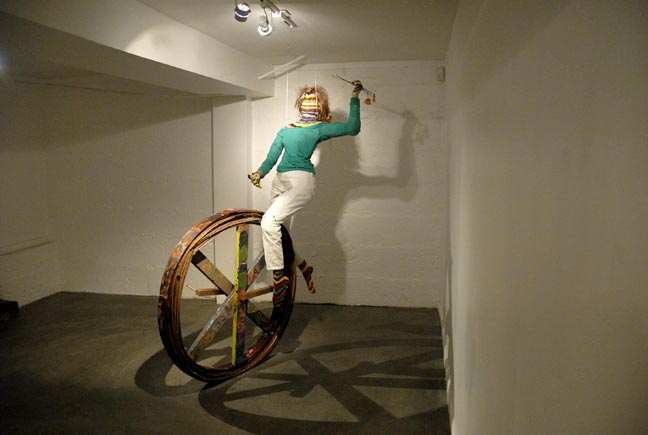
Art.

Closeup of above.

Art.

Art.

Art.
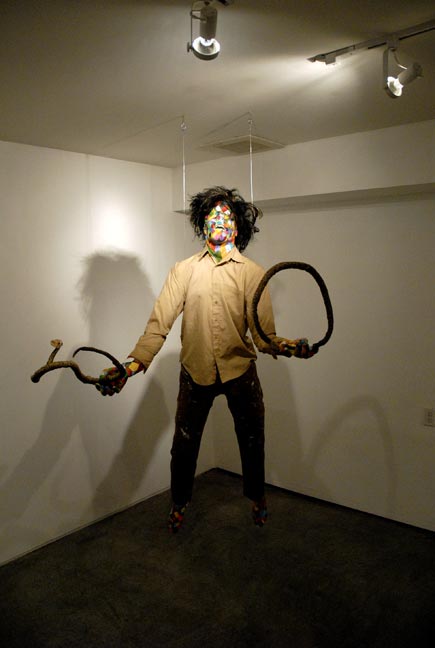
Art.
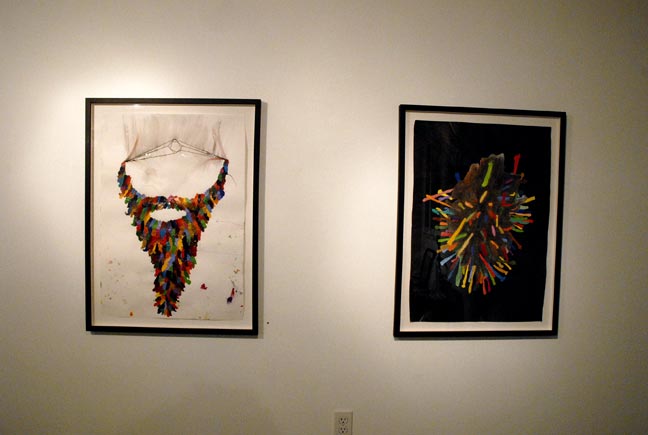
Art.
***




